Sociology Essay: Developments of Christian Doctrines in Middle Ages
VerifiedAdded on 2022/08/19
|9
|1878
|10
Essay
AI Summary
This essay examines the significant developments of Christian doctrines during the Early Middle Ages, primarily focusing on Western Europe. It argues that developments in science and architecture were influenced by the Christian faith. The essay details the spreading of Christianity, the influence of Christian doctrines on architecture and art, and the rise of monasticism and feudalism. It highlights the importance of the Edict of Milan, the evolution of church architecture, the development of fresco paintings, and the role of monks in preserving Christian learning. The essay concludes that Christian doctrines played a large role in the development of the early Middle Ages and its various aspects including renaissance art, feudalism, and artistic traditions.
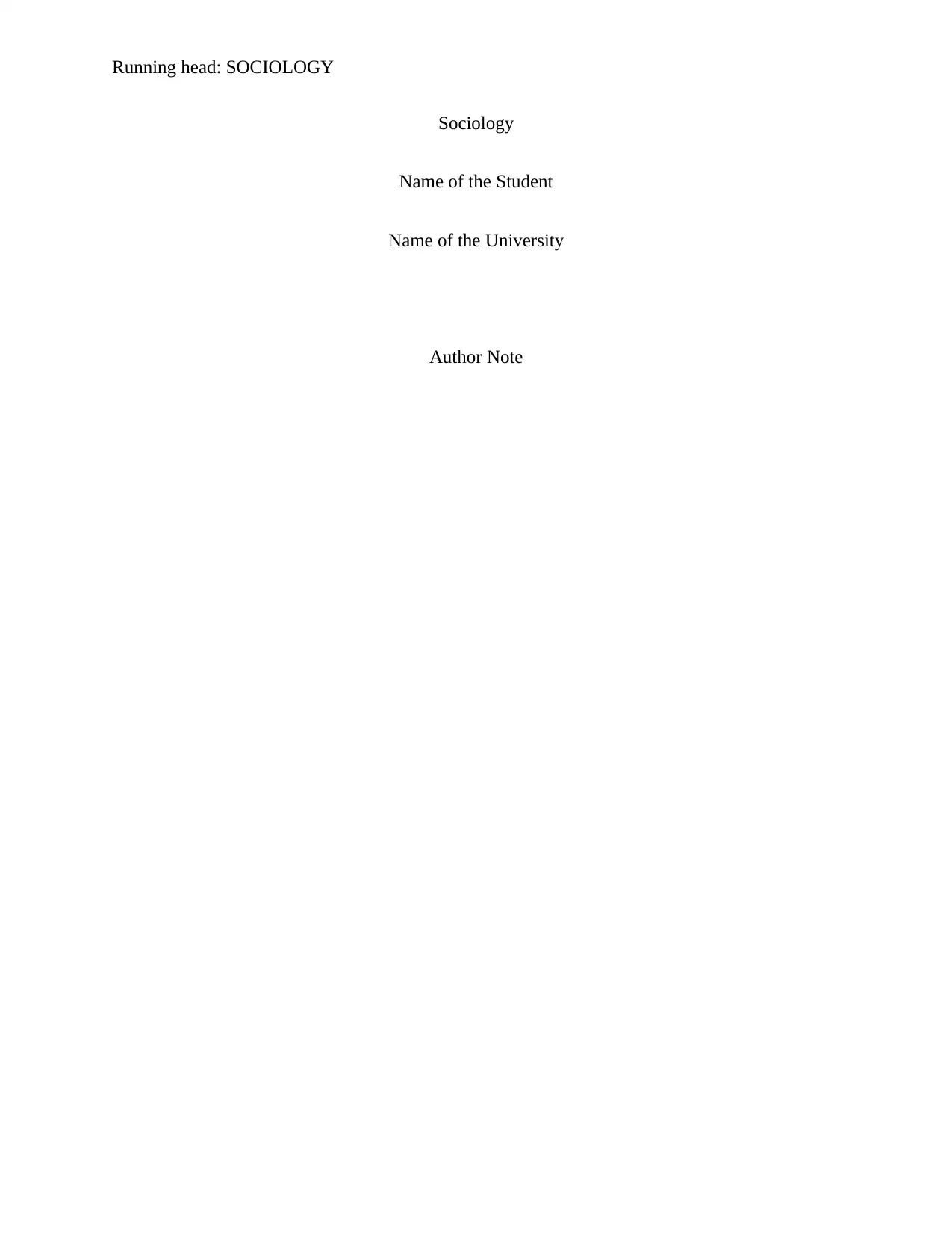
Running head: SOCIOLOGY
Sociology
Name of the Student
Name of the University
Author Note
Sociology
Name of the Student
Name of the University
Author Note
Paraphrase This Document
Need a fresh take? Get an instant paraphrase of this document with our AI Paraphraser
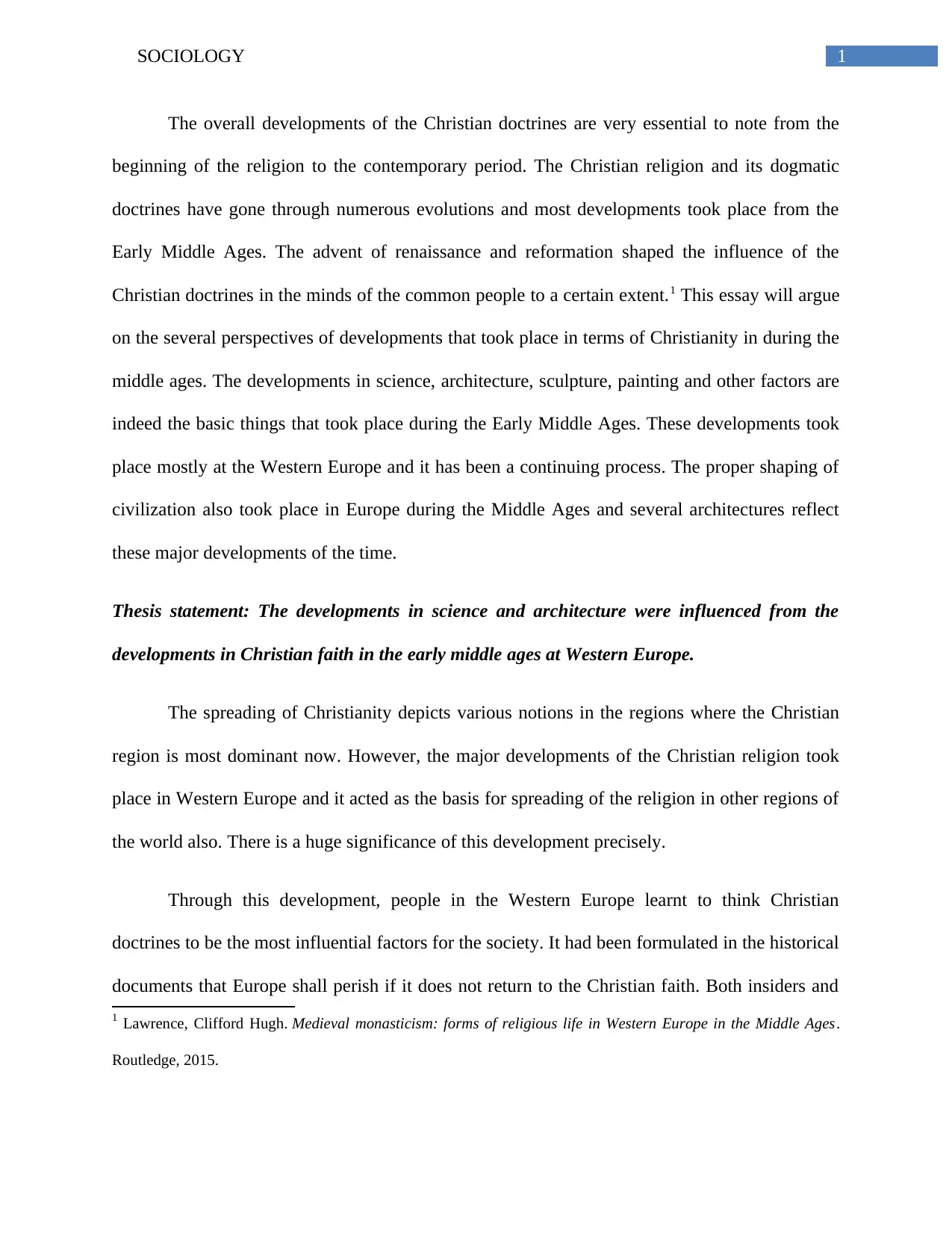
1SOCIOLOGY
The overall developments of the Christian doctrines are very essential to note from the
beginning of the religion to the contemporary period. The Christian religion and its dogmatic
doctrines have gone through numerous evolutions and most developments took place from the
Early Middle Ages. The advent of renaissance and reformation shaped the influence of the
Christian doctrines in the minds of the common people to a certain extent.1 This essay will argue
on the several perspectives of developments that took place in terms of Christianity in during the
middle ages. The developments in science, architecture, sculpture, painting and other factors are
indeed the basic things that took place during the Early Middle Ages. These developments took
place mostly at the Western Europe and it has been a continuing process. The proper shaping of
civilization also took place in Europe during the Middle Ages and several architectures reflect
these major developments of the time.
Thesis statement: The developments in science and architecture were influenced from the
developments in Christian faith in the early middle ages at Western Europe.
The spreading of Christianity depicts various notions in the regions where the Christian
region is most dominant now. However, the major developments of the Christian religion took
place in Western Europe and it acted as the basis for spreading of the religion in other regions of
the world also. There is a huge significance of this development precisely.
Through this development, people in the Western Europe learnt to think Christian
doctrines to be the most influential factors for the society. It had been formulated in the historical
documents that Europe shall perish if it does not return to the Christian faith. Both insiders and
1 Lawrence, Clifford Hugh. Medieval monasticism: forms of religious life in Western Europe in the Middle Ages.
Routledge, 2015.
The overall developments of the Christian doctrines are very essential to note from the
beginning of the religion to the contemporary period. The Christian religion and its dogmatic
doctrines have gone through numerous evolutions and most developments took place from the
Early Middle Ages. The advent of renaissance and reformation shaped the influence of the
Christian doctrines in the minds of the common people to a certain extent.1 This essay will argue
on the several perspectives of developments that took place in terms of Christianity in during the
middle ages. The developments in science, architecture, sculpture, painting and other factors are
indeed the basic things that took place during the Early Middle Ages. These developments took
place mostly at the Western Europe and it has been a continuing process. The proper shaping of
civilization also took place in Europe during the Middle Ages and several architectures reflect
these major developments of the time.
Thesis statement: The developments in science and architecture were influenced from the
developments in Christian faith in the early middle ages at Western Europe.
The spreading of Christianity depicts various notions in the regions where the Christian
region is most dominant now. However, the major developments of the Christian religion took
place in Western Europe and it acted as the basis for spreading of the religion in other regions of
the world also. There is a huge significance of this development precisely.
Through this development, people in the Western Europe learnt to think Christian
doctrines to be the most influential factors for the society. It had been formulated in the historical
documents that Europe shall perish if it does not return to the Christian faith. Both insiders and
1 Lawrence, Clifford Hugh. Medieval monasticism: forms of religious life in Western Europe in the Middle Ages.
Routledge, 2015.

2SOCIOLOGY
outsiders of Europe have identified the fact that Christian faith in its actual form has been
derived from the European background.2 The proper beginning of Christianity was from the time
when apostles came with the message of the Christian faith from the New Testament.
Many bishops and priests belonging to the Latin Christendom established the various
forms of Christian faith through the evolution of the canonical messages and Christian doctrines.
These doctrines are very crucial for the development of the understanding of Christian beliefs in
the society.3 Throughout the Early Middle Ages Rome became one of the major places for the
worshipping of Christianity. Most of the people from became Christians and they worshipped
like the Christians did.
After this incident, Western Europe was the central point for the establishment of
Christian doctrines. It was in the year 312 A.D. when Maxentius was defeated by Emperor
Constantine. This event took place at the Milvian bridge battle. After this event, the spreading of
Christian faith and doctrines became inevitable. It was evident from the fact that Emperor
Constantine had seen a sign that indicated his victory.4 Eusebius was the chief biographer of
Constantine who said this to be the sign of Chi Rho. These two were the very first two letters of
the Greek word Christos.
2 Rosenwein, Barbara H. A short history of the Middle Ages. University of Toronto Press, 2018.
3 Lawrence, Clifford Hugh. Medieval monasticism: forms of religious life in Western Europe in the Middle Ages.
Routledge, 2015.
4 Atkinson, Clarissa W. The Oldest Vocation: Christian Motherhood in the Medieval West. Cornell University Press,
2019.
outsiders of Europe have identified the fact that Christian faith in its actual form has been
derived from the European background.2 The proper beginning of Christianity was from the time
when apostles came with the message of the Christian faith from the New Testament.
Many bishops and priests belonging to the Latin Christendom established the various
forms of Christian faith through the evolution of the canonical messages and Christian doctrines.
These doctrines are very crucial for the development of the understanding of Christian beliefs in
the society.3 Throughout the Early Middle Ages Rome became one of the major places for the
worshipping of Christianity. Most of the people from became Christians and they worshipped
like the Christians did.
After this incident, Western Europe was the central point for the establishment of
Christian doctrines. It was in the year 312 A.D. when Maxentius was defeated by Emperor
Constantine. This event took place at the Milvian bridge battle. After this event, the spreading of
Christian faith and doctrines became inevitable. It was evident from the fact that Emperor
Constantine had seen a sign that indicated his victory.4 Eusebius was the chief biographer of
Constantine who said this to be the sign of Chi Rho. These two were the very first two letters of
the Greek word Christos.
2 Rosenwein, Barbara H. A short history of the Middle Ages. University of Toronto Press, 2018.
3 Lawrence, Clifford Hugh. Medieval monasticism: forms of religious life in Western Europe in the Middle Ages.
Routledge, 2015.
4 Atkinson, Clarissa W. The Oldest Vocation: Christian Motherhood in the Medieval West. Cornell University Press,
2019.
⊘ This is a preview!⊘
Do you want full access?
Subscribe today to unlock all pages.

Trusted by 1+ million students worldwide
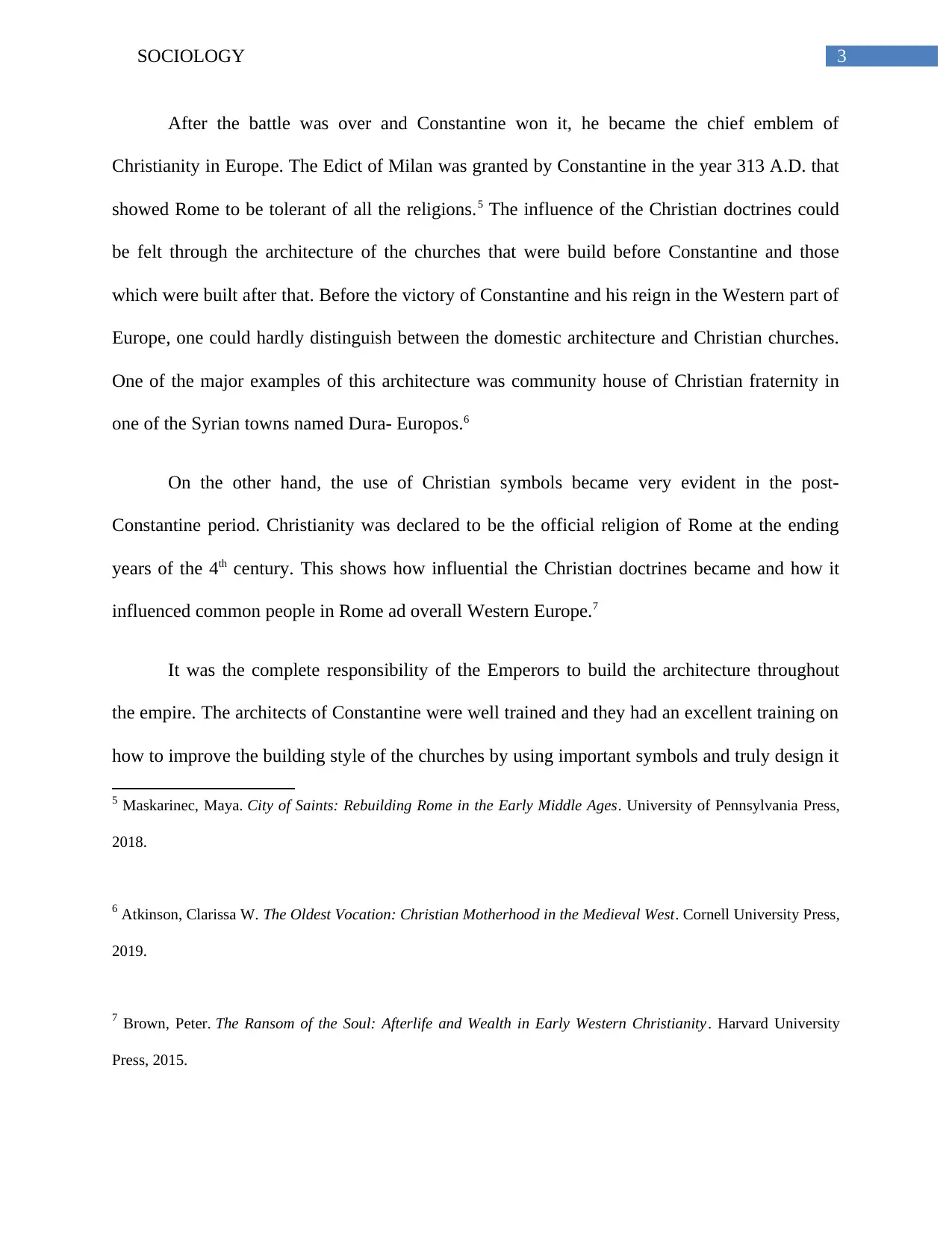
3SOCIOLOGY
After the battle was over and Constantine won it, he became the chief emblem of
Christianity in Europe. The Edict of Milan was granted by Constantine in the year 313 A.D. that
showed Rome to be tolerant of all the religions.5 The influence of the Christian doctrines could
be felt through the architecture of the churches that were build before Constantine and those
which were built after that. Before the victory of Constantine and his reign in the Western part of
Europe, one could hardly distinguish between the domestic architecture and Christian churches.
One of the major examples of this architecture was community house of Christian fraternity in
one of the Syrian towns named Dura- Europos.6
On the other hand, the use of Christian symbols became very evident in the post-
Constantine period. Christianity was declared to be the official religion of Rome at the ending
years of the 4th century. This shows how influential the Christian doctrines became and how it
influenced common people in Rome ad overall Western Europe.7
It was the complete responsibility of the Emperors to build the architecture throughout
the empire. The architects of Constantine were well trained and they had an excellent training on
how to improve the building style of the churches by using important symbols and truly design it
5 Maskarinec, Maya. City of Saints: Rebuilding Rome in the Early Middle Ages. University of Pennsylvania Press,
2018.
6 Atkinson, Clarissa W. The Oldest Vocation: Christian Motherhood in the Medieval West. Cornell University Press,
2019.
7 Brown, Peter. The Ransom of the Soul: Afterlife and Wealth in Early Western Christianity. Harvard University
Press, 2015.
After the battle was over and Constantine won it, he became the chief emblem of
Christianity in Europe. The Edict of Milan was granted by Constantine in the year 313 A.D. that
showed Rome to be tolerant of all the religions.5 The influence of the Christian doctrines could
be felt through the architecture of the churches that were build before Constantine and those
which were built after that. Before the victory of Constantine and his reign in the Western part of
Europe, one could hardly distinguish between the domestic architecture and Christian churches.
One of the major examples of this architecture was community house of Christian fraternity in
one of the Syrian towns named Dura- Europos.6
On the other hand, the use of Christian symbols became very evident in the post-
Constantine period. Christianity was declared to be the official religion of Rome at the ending
years of the 4th century. This shows how influential the Christian doctrines became and how it
influenced common people in Rome ad overall Western Europe.7
It was the complete responsibility of the Emperors to build the architecture throughout
the empire. The architects of Constantine were well trained and they had an excellent training on
how to improve the building style of the churches by using important symbols and truly design it
5 Maskarinec, Maya. City of Saints: Rebuilding Rome in the Early Middle Ages. University of Pennsylvania Press,
2018.
6 Atkinson, Clarissa W. The Oldest Vocation: Christian Motherhood in the Medieval West. Cornell University Press,
2019.
7 Brown, Peter. The Ransom of the Soul: Afterlife and Wealth in Early Western Christianity. Harvard University
Press, 2015.
Paraphrase This Document
Need a fresh take? Get an instant paraphrase of this document with our AI Paraphraser

4SOCIOLOGY
as the house of God or Jesus Christ.8 The events of baptism took place over there for a long
period of time. The building styles of churches were the symbol of their respect to the Christian
religious traditions and obeying the messages of the Christian doctrines. The evolution of the
Christian doctrines of the time gave birth to the stern beliefs in Christian theology and threw
challenges at the orthodoxy that ran supreme during those times.9
It must be said that religious attributes were highly dominated by the Catholic Church.
Therefore, it was quite effective to believe that the pagan practices were still going on within the
society. Amidst these volatile conditions, people saw the emergence of painting and sculpture
also. Various painters began the practice of the fresco painting in the churches in Rome and
Constanitinople. This became a trend in the Western Europe and painters engaged in decorating
the interiors of church buildings through these fresco paintings. The meaning of this term is
‘fresh’ according to the Italian language.10
In the Early Middle Ages, the growth of the Fresco painting could be traced back to the
painting of medieval paintings in Russia. The medieval painting had been influenced by the
Gothic tradition that occupies an immense space in the medieval art traditions and created an
influence over the Christian practices of the time. These paintings could also be termed as pre-
renaissance painting. The growth of these types of paintings is indeed very important to trace the
developments of the Christian influences in the traditions of the Early Middle Ages. Some of the
famous fresco paintings of this time are Sistine Chapel frescoes, Christ handing the Keys to St.
8
9 Adams, Laurie Schneider. Italian renaissance art. Routledge, 2018.
10 Reuter, Timothy. Germany in the early Middle Ages c. 800-1056. Routledge, 2014.
as the house of God or Jesus Christ.8 The events of baptism took place over there for a long
period of time. The building styles of churches were the symbol of their respect to the Christian
religious traditions and obeying the messages of the Christian doctrines. The evolution of the
Christian doctrines of the time gave birth to the stern beliefs in Christian theology and threw
challenges at the orthodoxy that ran supreme during those times.9
It must be said that religious attributes were highly dominated by the Catholic Church.
Therefore, it was quite effective to believe that the pagan practices were still going on within the
society. Amidst these volatile conditions, people saw the emergence of painting and sculpture
also. Various painters began the practice of the fresco painting in the churches in Rome and
Constanitinople. This became a trend in the Western Europe and painters engaged in decorating
the interiors of church buildings through these fresco paintings. The meaning of this term is
‘fresh’ according to the Italian language.10
In the Early Middle Ages, the growth of the Fresco painting could be traced back to the
painting of medieval paintings in Russia. The medieval painting had been influenced by the
Gothic tradition that occupies an immense space in the medieval art traditions and created an
influence over the Christian practices of the time. These paintings could also be termed as pre-
renaissance painting. The growth of these types of paintings is indeed very important to trace the
developments of the Christian influences in the traditions of the Early Middle Ages. Some of the
famous fresco paintings of this time are Sistine Chapel frescoes, Christ handing the Keys to St.
8
9 Adams, Laurie Schneider. Italian renaissance art. Routledge, 2018.
10 Reuter, Timothy. Germany in the early Middle Ages c. 800-1056. Routledge, 2014.
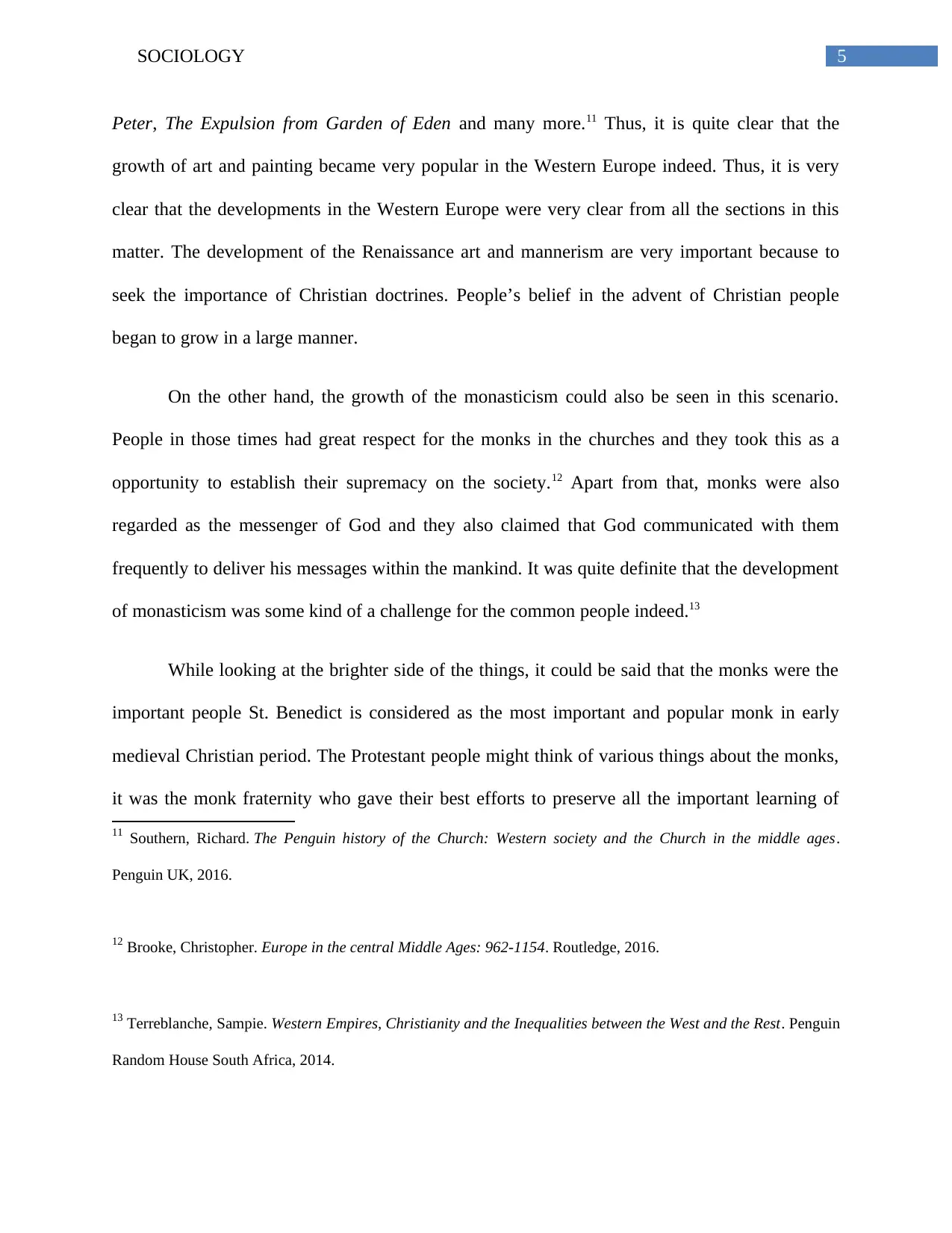
5SOCIOLOGY
Peter, The Expulsion from Garden of Eden and many more.11 Thus, it is quite clear that the
growth of art and painting became very popular in the Western Europe indeed. Thus, it is very
clear that the developments in the Western Europe were very clear from all the sections in this
matter. The development of the Renaissance art and mannerism are very important because to
seek the importance of Christian doctrines. People’s belief in the advent of Christian people
began to grow in a large manner.
On the other hand, the growth of the monasticism could also be seen in this scenario.
People in those times had great respect for the monks in the churches and they took this as a
opportunity to establish their supremacy on the society.12 Apart from that, monks were also
regarded as the messenger of God and they also claimed that God communicated with them
frequently to deliver his messages within the mankind. It was quite definite that the development
of monasticism was some kind of a challenge for the common people indeed.13
While looking at the brighter side of the things, it could be said that the monks were the
important people St. Benedict is considered as the most important and popular monk in early
medieval Christian period. The Protestant people might think of various things about the monks,
it was the monk fraternity who gave their best efforts to preserve all the important learning of
11 Southern, Richard. The Penguin history of the Church: Western society and the Church in the middle ages.
Penguin UK, 2016.
12 Brooke, Christopher. Europe in the central Middle Ages: 962-1154. Routledge, 2016.
13 Terreblanche, Sampie. Western Empires, Christianity and the Inequalities between the West and the Rest. Penguin
Random House South Africa, 2014.
Peter, The Expulsion from Garden of Eden and many more.11 Thus, it is quite clear that the
growth of art and painting became very popular in the Western Europe indeed. Thus, it is very
clear that the developments in the Western Europe were very clear from all the sections in this
matter. The development of the Renaissance art and mannerism are very important because to
seek the importance of Christian doctrines. People’s belief in the advent of Christian people
began to grow in a large manner.
On the other hand, the growth of the monasticism could also be seen in this scenario.
People in those times had great respect for the monks in the churches and they took this as a
opportunity to establish their supremacy on the society.12 Apart from that, monks were also
regarded as the messenger of God and they also claimed that God communicated with them
frequently to deliver his messages within the mankind. It was quite definite that the development
of monasticism was some kind of a challenge for the common people indeed.13
While looking at the brighter side of the things, it could be said that the monks were the
important people St. Benedict is considered as the most important and popular monk in early
medieval Christian period. The Protestant people might think of various things about the monks,
it was the monk fraternity who gave their best efforts to preserve all the important learning of
11 Southern, Richard. The Penguin history of the Church: Western society and the Church in the middle ages.
Penguin UK, 2016.
12 Brooke, Christopher. Europe in the central Middle Ages: 962-1154. Routledge, 2016.
13 Terreblanche, Sampie. Western Empires, Christianity and the Inequalities between the West and the Rest. Penguin
Random House South Africa, 2014.
⊘ This is a preview!⊘
Do you want full access?
Subscribe today to unlock all pages.

Trusted by 1+ million students worldwide
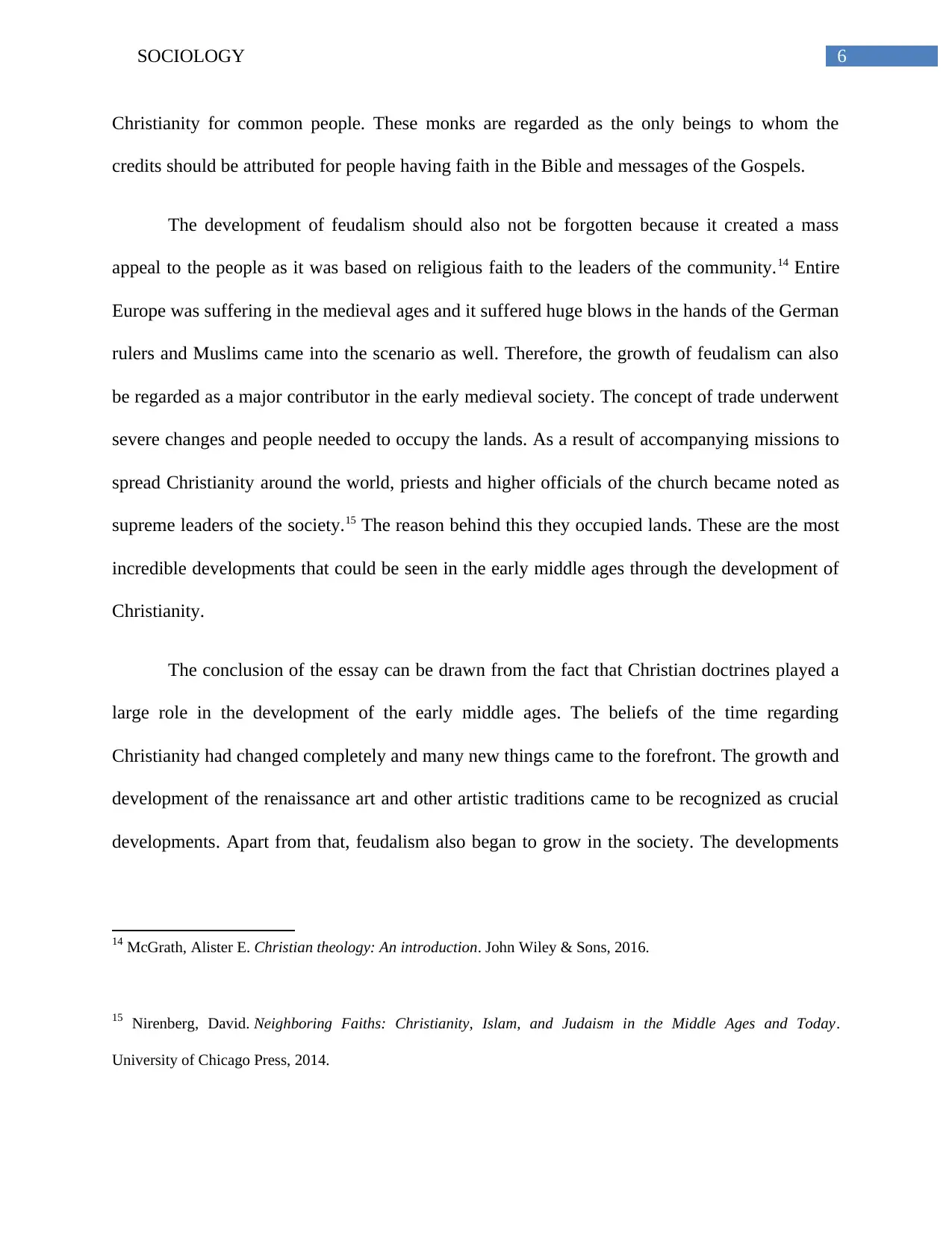
6SOCIOLOGY
Christianity for common people. These monks are regarded as the only beings to whom the
credits should be attributed for people having faith in the Bible and messages of the Gospels.
The development of feudalism should also not be forgotten because it created a mass
appeal to the people as it was based on religious faith to the leaders of the community.14 Entire
Europe was suffering in the medieval ages and it suffered huge blows in the hands of the German
rulers and Muslims came into the scenario as well. Therefore, the growth of feudalism can also
be regarded as a major contributor in the early medieval society. The concept of trade underwent
severe changes and people needed to occupy the lands. As a result of accompanying missions to
spread Christianity around the world, priests and higher officials of the church became noted as
supreme leaders of the society.15 The reason behind this they occupied lands. These are the most
incredible developments that could be seen in the early middle ages through the development of
Christianity.
The conclusion of the essay can be drawn from the fact that Christian doctrines played a
large role in the development of the early middle ages. The beliefs of the time regarding
Christianity had changed completely and many new things came to the forefront. The growth and
development of the renaissance art and other artistic traditions came to be recognized as crucial
developments. Apart from that, feudalism also began to grow in the society. The developments
14 McGrath, Alister E. Christian theology: An introduction. John Wiley & Sons, 2016.
15 Nirenberg, David. Neighboring Faiths: Christianity, Islam, and Judaism in the Middle Ages and Today.
University of Chicago Press, 2014.
Christianity for common people. These monks are regarded as the only beings to whom the
credits should be attributed for people having faith in the Bible and messages of the Gospels.
The development of feudalism should also not be forgotten because it created a mass
appeal to the people as it was based on religious faith to the leaders of the community.14 Entire
Europe was suffering in the medieval ages and it suffered huge blows in the hands of the German
rulers and Muslims came into the scenario as well. Therefore, the growth of feudalism can also
be regarded as a major contributor in the early medieval society. The concept of trade underwent
severe changes and people needed to occupy the lands. As a result of accompanying missions to
spread Christianity around the world, priests and higher officials of the church became noted as
supreme leaders of the society.15 The reason behind this they occupied lands. These are the most
incredible developments that could be seen in the early middle ages through the development of
Christianity.
The conclusion of the essay can be drawn from the fact that Christian doctrines played a
large role in the development of the early middle ages. The beliefs of the time regarding
Christianity had changed completely and many new things came to the forefront. The growth and
development of the renaissance art and other artistic traditions came to be recognized as crucial
developments. Apart from that, feudalism also began to grow in the society. The developments
14 McGrath, Alister E. Christian theology: An introduction. John Wiley & Sons, 2016.
15 Nirenberg, David. Neighboring Faiths: Christianity, Islam, and Judaism in the Middle Ages and Today.
University of Chicago Press, 2014.
Paraphrase This Document
Need a fresh take? Get an instant paraphrase of this document with our AI Paraphraser
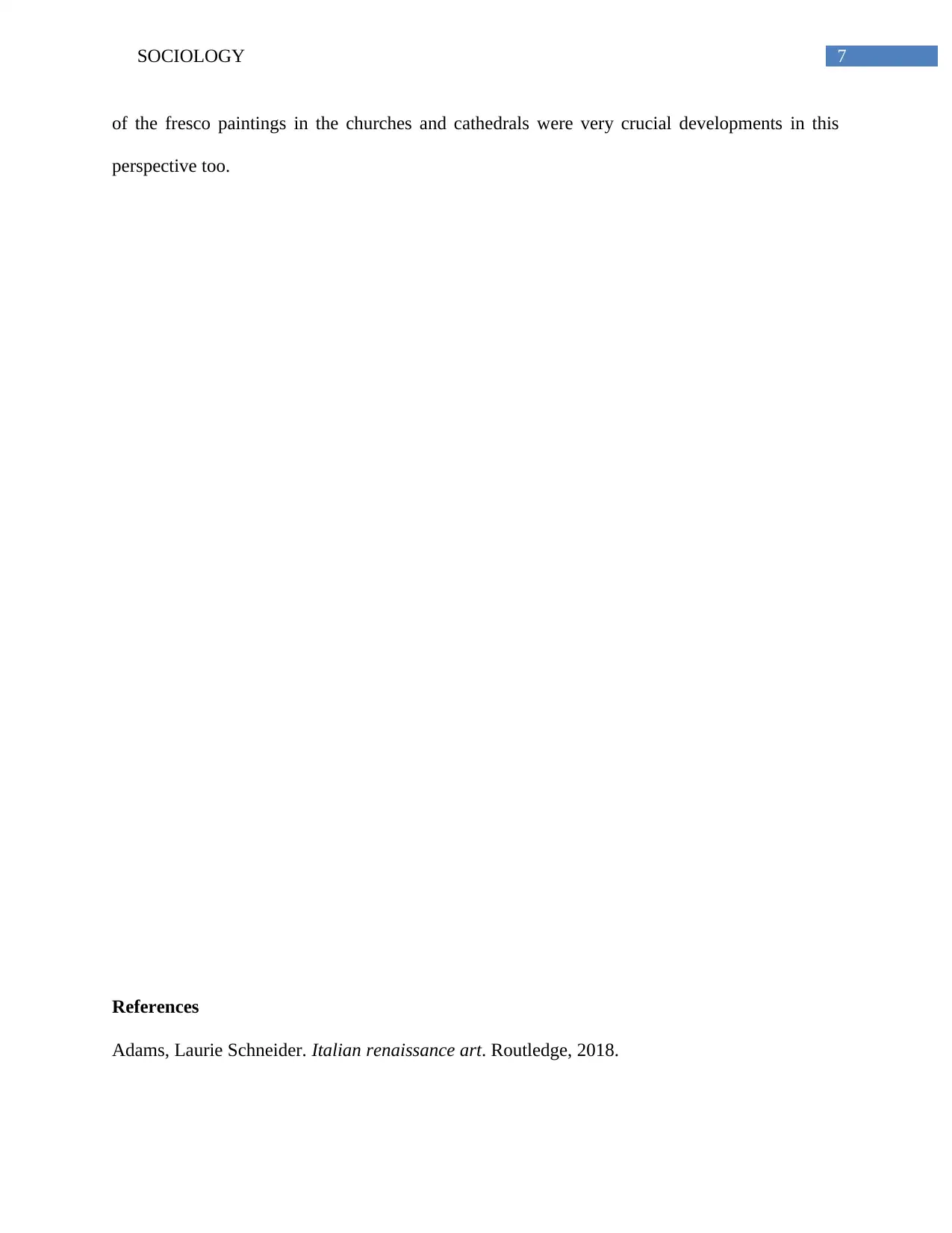
7SOCIOLOGY
of the fresco paintings in the churches and cathedrals were very crucial developments in this
perspective too.
References
Adams, Laurie Schneider. Italian renaissance art. Routledge, 2018.
of the fresco paintings in the churches and cathedrals were very crucial developments in this
perspective too.
References
Adams, Laurie Schneider. Italian renaissance art. Routledge, 2018.
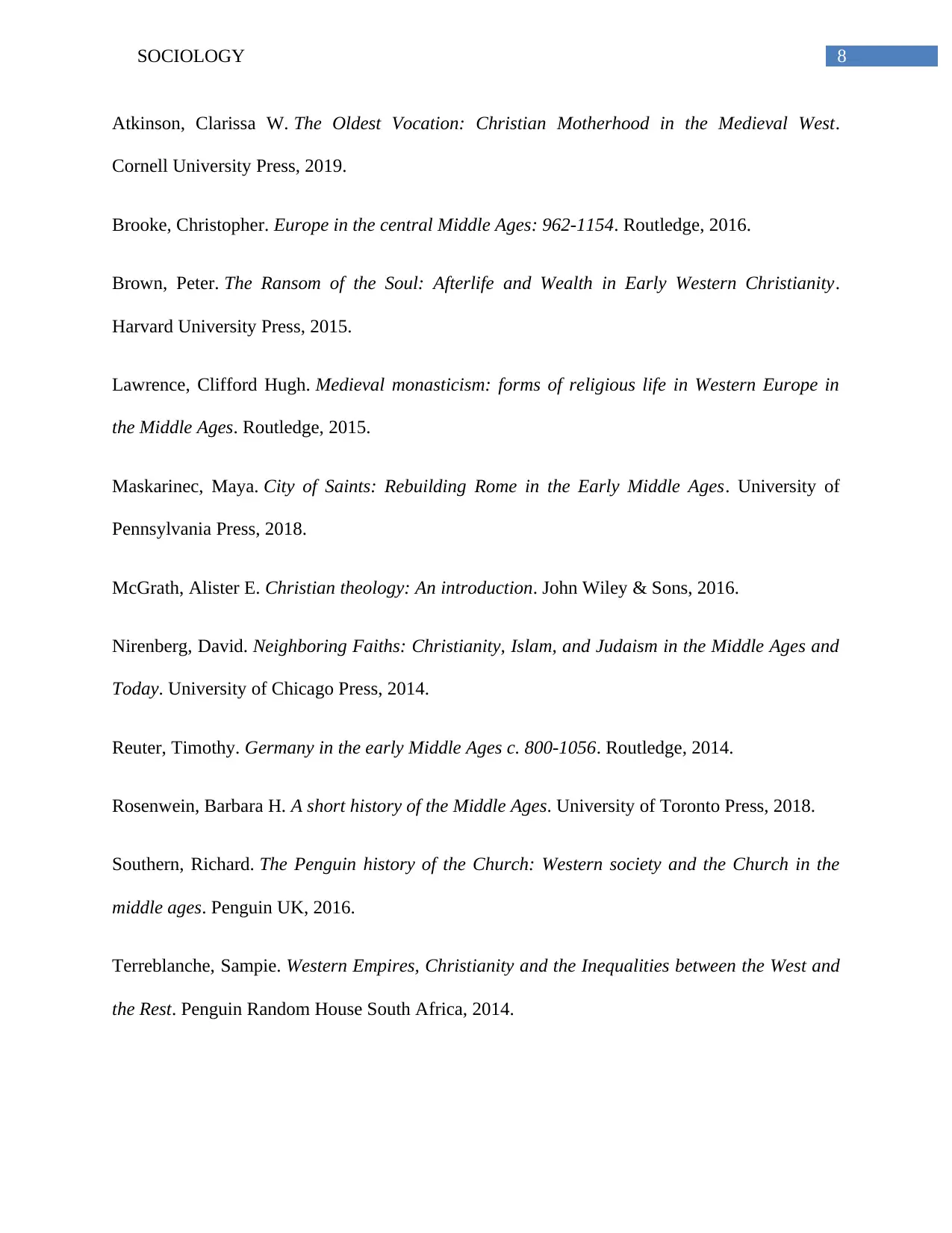
8SOCIOLOGY
Atkinson, Clarissa W. The Oldest Vocation: Christian Motherhood in the Medieval West.
Cornell University Press, 2019.
Brooke, Christopher. Europe in the central Middle Ages: 962-1154. Routledge, 2016.
Brown, Peter. The Ransom of the Soul: Afterlife and Wealth in Early Western Christianity.
Harvard University Press, 2015.
Lawrence, Clifford Hugh. Medieval monasticism: forms of religious life in Western Europe in
the Middle Ages. Routledge, 2015.
Maskarinec, Maya. City of Saints: Rebuilding Rome in the Early Middle Ages. University of
Pennsylvania Press, 2018.
McGrath, Alister E. Christian theology: An introduction. John Wiley & Sons, 2016.
Nirenberg, David. Neighboring Faiths: Christianity, Islam, and Judaism in the Middle Ages and
Today. University of Chicago Press, 2014.
Reuter, Timothy. Germany in the early Middle Ages c. 800-1056. Routledge, 2014.
Rosenwein, Barbara H. A short history of the Middle Ages. University of Toronto Press, 2018.
Southern, Richard. The Penguin history of the Church: Western society and the Church in the
middle ages. Penguin UK, 2016.
Terreblanche, Sampie. Western Empires, Christianity and the Inequalities between the West and
the Rest. Penguin Random House South Africa, 2014.
Atkinson, Clarissa W. The Oldest Vocation: Christian Motherhood in the Medieval West.
Cornell University Press, 2019.
Brooke, Christopher. Europe in the central Middle Ages: 962-1154. Routledge, 2016.
Brown, Peter. The Ransom of the Soul: Afterlife and Wealth in Early Western Christianity.
Harvard University Press, 2015.
Lawrence, Clifford Hugh. Medieval monasticism: forms of religious life in Western Europe in
the Middle Ages. Routledge, 2015.
Maskarinec, Maya. City of Saints: Rebuilding Rome in the Early Middle Ages. University of
Pennsylvania Press, 2018.
McGrath, Alister E. Christian theology: An introduction. John Wiley & Sons, 2016.
Nirenberg, David. Neighboring Faiths: Christianity, Islam, and Judaism in the Middle Ages and
Today. University of Chicago Press, 2014.
Reuter, Timothy. Germany in the early Middle Ages c. 800-1056. Routledge, 2014.
Rosenwein, Barbara H. A short history of the Middle Ages. University of Toronto Press, 2018.
Southern, Richard. The Penguin history of the Church: Western society and the Church in the
middle ages. Penguin UK, 2016.
Terreblanche, Sampie. Western Empires, Christianity and the Inequalities between the West and
the Rest. Penguin Random House South Africa, 2014.
⊘ This is a preview!⊘
Do you want full access?
Subscribe today to unlock all pages.

Trusted by 1+ million students worldwide
1 out of 9
Related Documents
Your All-in-One AI-Powered Toolkit for Academic Success.
+13062052269
info@desklib.com
Available 24*7 on WhatsApp / Email
![[object Object]](/_next/static/media/star-bottom.7253800d.svg)
Unlock your academic potential
Copyright © 2020–2025 A2Z Services. All Rights Reserved. Developed and managed by ZUCOL.





